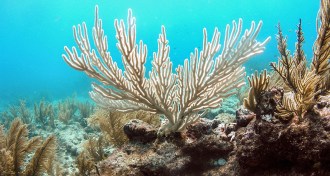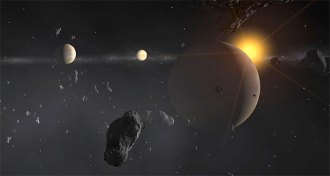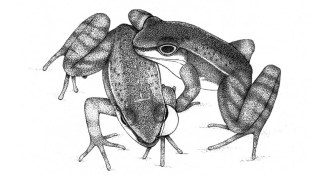All Stories
-
 Animals
AnimalsWhales are full of toxic chemicals
For decades, scientists have been finding troublesome levels of PCBs, mercury and other toxic chemicals in whales and dolphins.
-
 Science & Society
Science & SocietyHuman evolution, biomimicry and more go on display
A new human evolution gallery and a lecture series on Europa are among science events to explore in February 2016.
-
 Oceans
OceansOcean heating doubles
Earth’s oceans now absorb twice as much heat as they did 18 years ago, with more than a third of that warmth going into the ocean depths.
-
 Astronomy
AstronomyThe votes are in: Exoplanets get new names
Arion, Galileo and Poltergeist are just three winners of a contest to name planets and suns in 20 solar systems.
-
 Genetics
GeneticsBubonic plague hung out in Europe
The plague bacterium Yersinia pestis may have lurked in a medieval European reservoir for at least 300 years, researchers from Germany suggest January 13 in PLOS ONE.
-
 Genetics
GeneticsBubonic plague hung around in Europe
DNA from plague victims suggests that a European reservoir of the plague bacterium Yersinia pestis could have fueled the medieval pandemic.
-
 Health & Medicine
Health & MedicineCDC issues travel guidelines for pregnant women
Pregnant women should consider postponing travel to much of Latin America and the Caribbean.
By Meghan Rosen -
 Health & Medicine
Health & MedicineLow-fiber diets make gut microbes poop out
A low-fiber diet makes for low bacterial diversity in mice. A new study shows those mice can then pass a denuded microbiome on to their offspring.
-
 Animals
AnimalsTorrent frog flirting is complicated
The courtship displays of Brazilian torrent frogs entail a subtle but sophisticated slew of songs and movements.
-
 Life
LifeSearch is on for missing pieces in puzzle of male genital diversity
The debate over extreme diversity of male genitalia needs to rethink the female side. And the landscape.
By Susan Milius -
 Archaeology
ArchaeologyHumans visited Arctic earlier than thought
Human weapon injuries on mammoth bones show humans were in the Arctic up to 15,000 years earlier than researchers thought.
-
 Neuroscience
NeuroscienceMeasuring brain waves may help predict a patient’s response to anesthesia
Brain signatures hint at whether a person will resist or succumb to anesthesia.